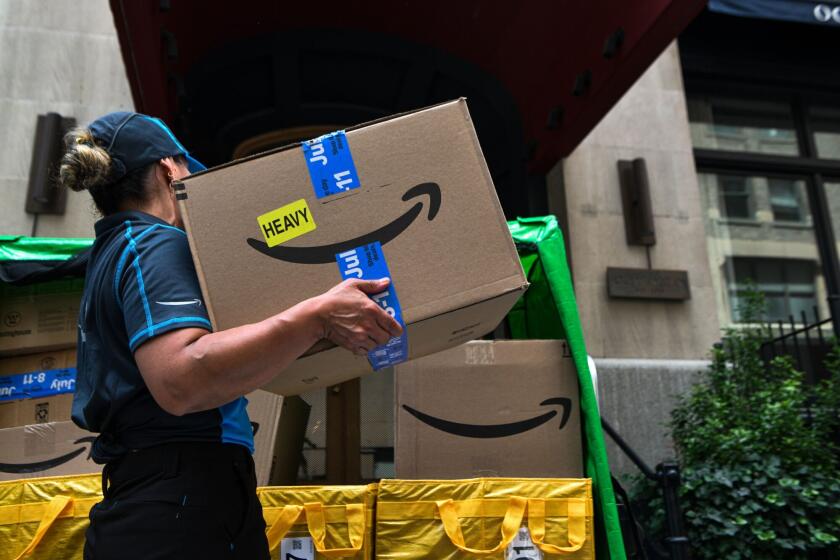September retail sales rise 0.6%, survey finds
- Share via
Retailers last month posted their first uptick in sales in more than a year, providing a hopeful sign for the industry and the broader economy as the crucial holiday shopping season draws near.
Although nagging concerns remain about consumers’ willingness to spend, retail sales in September turned out better than expected: Major department stores J.C. Penney Co., Macy’s Inc. and Nordstrom Inc. beat analysts’ expectations, while some chains including Kohl’s Corp., TJX Cos. and Ross Stores Inc. posted healthy increases.
The news helped pushed the Dow Jones industrial average up 61.29 points, or 0.6%, to 9,786.87.
Though the outlook remains uncertain, some economists say that if stocks hold up and the housing and job markets don’t worsen, Christmas holiday sales could surprise on the upside.
And that might prove to be critical for the economy. If consumers are really beginning to spend again, companies might start to hire, which could help speed a recovery.
“Most companies are very worried about consumers, and they’ve been reluctant to hire and invest because they believe consumers will trounce the economic recovery,” said Lynn Reaser, chief economist at Point Loma Nazarene University. “If they see signs that consumers are coming out of their holes, they’ll be more encouraged.”
Whether September’s sales will be part of a trend is not clear.
According to Thomson Reuters’ tally of 30 major chain stores, the increase over 2008 was just 0.6% -- and last year was a terrible year, when sales plunged amid the shock of a financial meltdown. In addition, Labor Day fell further into September this year, pushing more back-to-school spending into the month. Nationally, consumer confidence has ticked higher in recent weeks, but rising unemployment and tight credit have kept many potential spenders on the sidelines.
“We don’t think retailers are out of the woods by any stretch,” said Ken Perkins, president of research company Retail Metrics Inc. Largely because of the later Labor Day and delayed start dates for schools around the country, September numbers were inflated by about 3 to 4 percentage points, he said.
“There’s no clear-cut sign yet that consumers are opening up their purse strings,” Perkins said.
After last year’s dismal performance, another grim Christmas would be devastating for retailers, leading to business bankruptcies, higher mall vacancy rates and store closures.
But it would have even greater implications for the broader financial picture: With consumer spending accounting for about 70% of U.S. economic activity, a turnaround hinges on shoppers’ willingness to turn out and spend freely.
So as merchants put away the backpacks and school supplies and bring out the holiday merchandise, they are expected to offer deep discounts to attract wary consumers. They’re also bracing themselves by hiring fewer seasonal workers and cutting back on inventory.
“We’ve seen so many stores close, so many stores move out, it’s just kind of make or break,” said Ashley Heaton, a sales associate at accessories boutique Jennifer Kaufman in the Beverly Center. “We feel a lot of pressure.”
Industry experts carefully look at results from the back-to-school selling period as an indicator of how the holiday season will perform.
According to Thomson Reuters, 21 stores last month did better than analysts expected, and five did worse. An index of major retail stocks rose 1.8% Thursday.
Many of the strongest performers in September were sellers of mid- or low-priced goods. Teen retailer Aeropostale Inc. saw year-over-year sales rise 19%, and off-price chains Ross and TJX posted increases of 8% and 7%, respectively. Sales at mid-level department store chain Kohl’s rose 5.5%. All four retailers raised their quarterly outlook.
Abercrombie & Fitch Co. continued to struggle, posting an 18% decline, although that was better than the 21% drop analysts had predicted. Los Angeles-based American Apparel Inc. saw sales fall 15%, and luxury retailer Saks Inc. said sales fell 11.6%.
Results are based on sales at stores open at least a year, known as same-store sales and considered an important measure of a retailer’s health.
With business down at his Internet services and computer company, business owner Tony Javoric said these days, he’s “shopping for serious sales” only.
“Today I bought stuff from two of the men’s stores, and the only reason I bought was because it was exceptionally well-priced. Everything else I passed by,” Javoric said while shopping at Citadel Outlets in Los Angeles this week. “I don’t see the economy getting better anytime soon. That doesn’t encourage you to go out and spend.”
At the Beverly Center in L.A., shopper Kristin Larson, 28, said her holiday plans would include more baking and less buying.
“Money is tight,” she said. “I’m a server, and people are holding back on their gratuities, so that affects me.”
This week the National Retail Federation projected that sales during the November-December period would fall 1%, to $437.6 billion, compared with a year ago. That’s significantly worse than the 10-year average of 3.4% holiday season growth.
“We know that a lot of Americans will be pulling back on the holiday season because they have to,” Ellen Davis, the retail trade group’s vice president, said in a conference call with reporters. “This will be the holiday season of the blue jean instead of the Blu-ray.”
--
don.lee@latimes.com
More to Read
Inside the business of entertainment
The Wide Shot brings you news, analysis and insights on everything from streaming wars to production — and what it all means for the future.
You may occasionally receive promotional content from the Los Angeles Times.











